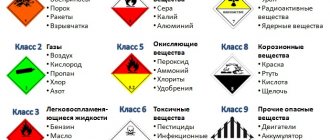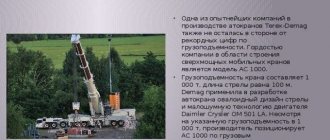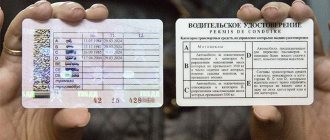REGULATORY DOCUMENTS
As you can see, only a small fraction of the aspects of transporting oversized goods are covered by the Road Traffic Rules. Basic regulation of the transportation of oversized cargo on the roads of the Russian Federation is carried out by Federal Law No. 257-FZ. In Chapter 5 of Article 31 you can find the following points:
- transportation of large and heavy cargo requires special permission;
- the procedure for obtaining a special permit is established by the government of the Russian Federation;
- Before transportation, it is necessary to coordinate the route with the owner of the roads;
- In case of damage, the amount of compensation is calculated by the owner of the road.
Based on the rights specified in the above-mentioned normative act, the “Rules for the carriage of goods by road” were drawn up. In this document you can find instructions regarding the procedure for organizing transportation, ensuring the safety of vehicles and containers, if necessary, conditions of transportation and provision of vehicles for transportation.
RELATED ORDERS AND RESOLUTIONS
In order to be guaranteed to protect yourself from problems when filling out an application for a special permit and directly when transporting oversized cargo, we recommend that you familiarize yourself with the following orders:
- No. 107: represents regulations for government agencies for issuing permits;
- No. 258: regulates the rules for issuing permits;
- No. 7: establishes rules to ensure safety when transporting oversized items.
Resolutions:
- No. 125: procedure for weight and dimensional control;
- No. 934 + No. 12: procedure for compensation for damage caused to the road;
- No. 125: rules for passing weight control;
- No. 211: establishes the rules for introducing a ban on cargo transportation.
Fines and punishments
To familiarize yourself with the amount of penalties imposed for violations of the rules for the transportation of oversized cargo, read Article 12.21.1 of the Code of Administrative Offenses of the Russian Federation. There you will find out exactly who should be punished for violations. For example, for not having a special permit, a driver can receive a fine of 2 thousand rubles, but, even worse, he can lose his driver’s license for up to six months.
Fine for protruding load (Article 12.21 of the Code of Administrative Offenses of the Russian Federation) (... how far the load can protrude)
Any of our vehicles from time to time transports not only passengers, but also cargo. At the same time, it is good if the cargo fits in the body or trunk, and sometimes it is necessary to transport large cargo. And this is where the question arises: how to transport cargo without incurring a fine. And if there is a fine, what will it be? This is what we will talk about.
Before “diving” into the depths of all kinds of rules and laws, let’s immediately say that we will be interested in cases relating to the transportation of goods up to certain sizes, that is, we will not touch upon the topic of transportation of large-sized cargo. Let's begin. The first thing you should turn to is the traffic rules. There are 2 points worth quoting here:
23.4.
A load protruding beyond the dimensions of the vehicle in front or behind by more than 1 m or from the side by more than 0.4 m from the outer edge of the side light must be marked with the identification signs “Large load”, and in the dark and in conditions of insufficient visibility In addition, there is a white light or reflector on the front, and a red light or reflector on the back.
A picture like this would be appropriate here. If the cargo is up to and including the specified dimensions, then a sign is not needed.
Here we can say that if you violated the rules for transporting non-large cargo, that is, up to these limits, then the fine will be minimal or even a warning. (Article 12.21 of the Code of Administrative Offenses of the Russian Federation). This applies to cases:
– does not limit the driver’s visibility; – does not complicate control and does not affect the stability of the vehicle; – does not cover external lighting devices and reflectors, registration and identification marks, and does not interfere with the perception of hand signals;
– does not create noise, does not generate dust, does not pollute the road or the environment.
(requirements from the same traffic rules).
If the dimensions “got out” beyond these limits, then we hang up a sign, or rather a “Large cargo” sign. Does this mean that protruding beyond more than 1 meter back and forth, relative to the dimensions, and more than 0.4 m on the sides relative to the side lights, the vehicle will be large? Well, let's turn to Federal Law 257 and find a definition for a large vehicle.
large-sized vehicle - a vehicle whose dimensions, with or without cargo, exceed the permissible dimensions established by the Government of the Russian Federation
Here we can draw an analogy and consider the protruding load to be large.
...if at least one of the dimensions of the vehicle together with the cargo exceeds the established value according to the traffic regulations, the cargo is considered oversized
At the same time, large cargo of certain sizes must be transported according to the rules, in accordance with clause 23.5 of the traffic rules. Let us quote this point as well.
23.5.
Transportation of heavy and dangerous goods, movement of a vehicle whose overall dimensions, with or without cargo, exceed 2.55 m in width (2.6 m for refrigerators and isothermal bodies), 4 m in height from the surface of the roadway, and in length ( including one trailer) 20 m, or the movement of a vehicle with a load protruding beyond the rear point of the vehicle's overall dimensions by more than 2 m, as well as the movement of road trains with two or more trailers are carried out in accordance with special rules. International road transport is carried out in accordance with the requirements for vehicles and transportation rules established by international treaties of the Russian Federation.
Please note that we have not only one size left, when the load outreach from the rear is more than 1 meter, but up to 2 meters. In this case, cargo of this size is not required to be transported according to the rules, but it is necessary to attach the “Large Cargo” sign to it.
Actually, we can already draw some conclusions. If the dimensions do not exceed 2.55 m in width, 20 m in length, 4 m from the road in height and 2 meters in the back, then even if it is a large cargo, it is transported without special rules, that is, only in accordance with traffic regulations.
If the dimensions are more than that, then here in accordance with the federal law of the Russian Federation of November 8, 2007.
No. 257-FZ “On highways and road activities in the Russian Federation and on amendments to certain legislative acts of the Russian Federation”, road users are prohibited from transporting large-sized cargo along highways without special permits.
We will not talk about these permits, that is, as we said right at the beginning of our article, we only touch upon cases for ordinary motorists, and not for professional carriers. Let's tell you better about the fine if your cargo extends beyond the limits indicated in the last picture.
Fine for transporting protruding cargo (Article 12.21 and 12.21.1 of the Code of Administrative Offenses of the Russian Federation)
Here we have three options regarding what the fine for the cargo may be. The first, when traffic rules for the transportation of goods are violated:
– does not limit the driver’s visibility; – does not complicate control and does not affect the stability of the vehicle; – does not cover external lighting devices and reflectors, registration and identification marks, and does not interfere with the perception of hand signals;
– does not create noise, does not generate dust, does not pollute the road or the environment.
The second is when it is necessary to install a “Large cargo” sign if the cargo protrudes beyond the rear clearance by more than 1 meter, but not more than 2 meters. If this sign is not installed, then... For these two options, a fine will be issued under Article 12.21 of the Code of Administrative Offenses of the Russian Federation.
Violation of the rules for transporting goods, as well as the rules for towing, entails a warning or the imposition of an administrative fine in the amount of 500 rubles.
The third option is when the cargo is large and, moreover, requires special permission, that is, it exceeds the dimensions. This will already be a fine under Article 12.21.1 of the Code of Administrative Offenses of the Russian Federation.
- if the dimensions are exceeded by no more than 10 cm (without a formalized permit available) - 1000-1500 rubles (individuals) (part 1); - if the dimensions are exceeded by 10-20 cm (without a formalized permit available) - 3000-4000 rubles (individuals) (part 2); - if the dimensions are exceeded by 20-50 cm (without a formalized permit available) - 5,000-10,000 rubles (individuals) (part 3);
– if the size exceeds more than 50 cm (without or with a formalized permit) – 7,000-10,000 rubles (individuals) or imprisonment from 4 to 6 months (part 6).
In fact, it is clear that the worst thing is if the load protrudes more than 50 cm. In this case, a very large fine or deprivation of a special right for up to six months.
Detention of a vehicle when transporting protruding cargo
It is noteworthy that for a violation under Article 12.21.1 of the Code of Administrative Offenses of the Russian Federation, that is, for our third case, detention may be used. This possibility is spelled out in Article 27.13 of the Code of Administrative Offenses of the Russian Federation. Moreover, if your car cannot be loaded onto a tow truck, they can simply install blocking devices. We read 27.13 Code of Administrative Offenses of the Russian Federation.
...If, due to the technical characteristics of the vehicle, it is impossible to move it and place it in a specialized parking lot in the event of committing an administrative offense provided for in Part 1, 2, 3, 4, 5 or 6 of Article 12.21.1 or Part 1 of Article 12.21.2 of this Code, detention is carried out by stopping movement using blocking devices.
As a result, you will remain there until you eliminate the reasons that led to the detention.
Is it possible to pay a fine for a protruding load with a 50 percent discount?
If you still failed to avoid a fine, then you should not forget about Article 32.2 of the Code of Administrative Offenses of the Russian Federation. Thanks to it, respectable motorists have the opportunity to pay a fine with a 50 percent discount. This article allows you to receive a kind of “discount” if the fine is paid within the period from the moment it appears in the traffic police fines database, but no later than 20 days from the date of the decision.
WHAT CARGO IS CONSIDERED OVERSIZED?
The cargo is considered oversized if its weight and/or size exceeds the value established by the traffic regulations of a particular country as acceptable during transportation. According to the traffic rules of the Russian Federation, oversized cargo is considered to be the following:
SDA ABOUT TRANSPORTATION
Paragraph 23.5 of the traffic rules states that vehicles transporting such cargo must be marked with the “Large cargo” sign. Additionally, in the dark (remember that this is considered the time from evening twilight to the beginning of twilight in the morning) and in conditions of poor visibility, a reflective element or a white light should be installed in the bow of the car, and a reflective element or a light source of sufficient power in the rear part Red. This is quite enough for driving on public roads.
SPECIAL REQUIREMENTS
Transportation of explosive, chemical or other dangerous goods, long objects or heavy loads is regulated by special standards established by the relevant government authorities. Special rules should be followed when driving a vehicle (with or without cargo) if:
Heavyweights
Also, special permission from the traffic police is required when transporting heavy cargo. What matters is the total weight of the vehicle and the object being transported. Specific values in different countries may differ, which should be taken into account when intending to cross the border. The definition of “heavy” in the Russian Federation includes:
- two-axle vehicles weighing more than 18 tons;
- three-axle vehicles weighing more than 25 tons;
- four-axle vehicles weighing more than 32 tons;
- road trains with 3 axles and weighing more than 28 tons;
- four-axle road trains weighing more than 36 tons;
- road trains with 5 and weighing more than 40 tons;
- road trains with 6 axles or more, weighing more than 44 tons.
Also, do not forget about the strict requirements for load distribution along the axles. Not only the distance between closely spaced axles matters, but also the standard loads of roads. When designing, constructing and reconstructing a roadway, the permissible axial load is set, for example, 6, 10 or 11.5 tons. That is why transportation can take place not along the shortest route, but with a choice of roads with a suitable load class.
Signs
Sign used to indicate oversized cargo:
Sign “Long-length road train” Long vehicle.
When transporting dangerous goods, the vehicle must be marked with the following sign:
COVER VEHICLE
Previously, if the length of a vehicle loaded with oversized cargo was more than 24 m, but less than 30 m, and the width was more than 3.5 m, but less than 4 m, then the appropriate conditions for transportation could be created by the transport company without the participation of representatives of the traffic police. But since 2014, when transporting heavy and oversized cargo, it is necessary to use a cover vehicle to ensure safety. Requirements for an accompanying vehicle:
- the presence of a yellow-orange stripe;
- presence of yellow and orange flashing lights;
- A reflective or illuminated sign must be installed, on which there will be an inscription warning about the characteristics of the cargo (for example, “Large length”).
TRAVEL ABROAD AND INTERREGIONAL TRANSPORTATION
If you intend to cross the border, please note that a car without a special international permit will be detained.
When passing a route through two or more territorial units of the upper level of the Russian Federation, an interregional permit must be obtained. As in the case of an international special permit, you can apply for it through the State Services website. You can fill out an application during a personal visit at the offices of the Road Management Administration of the Russian Federation or at its subsidiary branches.
HOW TO GET PERMISSION
Obtaining permission to transport oversized cargo is regulated by the so-called Order 258. It is in this document that you can find out:
- admission parameters and conditions for refusal to submit an application;
- a complete description of the procedure for drawing up and submitting an application;
- what the document should look like and what information should be included in it;
- subtleties when coordinating the transportation of heavy objects;
- established deadlines for obtaining permission;
- procedure for issuing a special permit or obtaining a refusal.
Traffic regulations requirements for the transportation of oversized cargo by road
Remember the famous thesis expressed by Ostap Bender: “A car is not a luxury, but a means of transportation”?
Nowadays it can be supplemented with the words “people and cargo”. While most motorists have no questions about the rules for transporting passengers, not everyone is familiar with the nuances associated with transporting goods. And this issue is given a whole section in the Traffic Rules.
Traffic rules requirements
In the traffic rules, section 23 is devoted to the transportation of goods, consisting of five points, in which the legislator has provided for all possible situations that arise during their transportation by road.
23.1 deals with permissible values for cargo mass. 23.2 requires the driver to control its placement and fastening.
23.1. The weight of the transported cargo and the load distribution along the axles must not exceed the values established by the manufacturer for this vehicle.
23.2. Before starting and while driving, the driver is obliged to control the placement, fastening and condition of the load in order to avoid it falling and creating obstacles to movement.
Clause 23.3 of the traffic rules clearly states when the carriage of cargo is allowed and has five paragraphs, of which it is worth mentioning something quite unusual for modern drivers that many drivers forget: the placement of cargo should not interfere with the perception of hand signals.
23.3. Transportation of cargo is permitted provided that it:
- does not limit the driver's visibility;
- does not complicate control and does not affect the stability of the vehicle;
- does not cover external lighting devices and reflectors, registration and identification marks, and does not interfere with the perception of hand signals;
- does not create noise, does not create dust, does not pollute the road or the environment.
If the condition and placement of the cargo do not meet the specified requirements, the driver is obliged to take measures to eliminate violations of the listed transportation rules or stop further movement.
Permissible dimensions of cargo for transportation by road
What is considered a large-sized cargo, the transportation of which does not require special permits, but has strictly defined transportation rules specified in the traffic rules?
23.4.
A load protruding beyond the dimensions of the vehicle in front and behind by more than 1 m or on the side by more than 0.4 m from the outer edge of the side light must be marked with identification signs “Large load”, and in the dark and in conditions of insufficient visibility In addition, in front - a flashlight or a white reflector, at the back - a flashlight or a red reflector.
By lenght
If the load protrudes beyond the front and rear dimensions of the vehicle by more than 1 m, but not more than 2 m. It should be noted here that despite the presence of the letter “and”, you can read “or”. Let’s say the load is extended more than a meter just beyond the rear side of the car, but not in front, it is already becoming large.
Width
It also indicates how much the load can protrude across the width of the car - no more than 40cm.
ATTENTION. Unlike the first case, where the length of the protruding part should be measured from the extreme point of the car, here the measurement is made from the edge of the rear marker light, which means that it will actually protrude slightly less than the prescribed 40cm, since the specified lamp is always located somewhat deeper than the extreme side point car.
If, after measurements, at least one parameter exceeds the above standards, it should be o, and in the dark or in case of insufficient visibility, also with flashlights or reflectors: white in front and red in back.
By height
Despite the fact that clause 23.4 of the traffic rules does not talk about the height of the load, it should be remembered that the load should not exceed four meters above the surface of the roadway (clause 23.5 of the traffic rules).
Let's consider this situation: the cargo does not protrude beyond the dimensions of the vehicle, but reaches a height of 3 meters 85 centimeters from the road surface; the “Large cargo” sign is not required.
Sometimes it happens.
Paragraph 23.5 of the traffic rules defines cargo and vehicles for transportation or passage of which will have to obtain a special permit:
23.5.
Transportation of heavy and dangerous goods, movement of a vehicle whose overall dimensions, with or without cargo, exceed 2.55 m in width (2.6 m for refrigerators and isothermal bodies), 4 m in height from the surface of the roadway, and in length ( including one trailer) 20 m, or the movement of a vehicle with a load protruding beyond the rear point of the vehicle's overall dimensions by more than 2 m, as well as the movement of road trains with two or more trailers are carried out in accordance with special rules.
International road transport is carried out in accordance with the requirements for vehicles and transportation rules established by international treaties of the Russian Federation.
Transportation rules
On the territory of the Russian Federation, the transportation of large cargo is regulated by a number of regulations, in addition to traffic rules, this includes:
- Decree of the Government of the Russian Federation dated April 15, 2011. No. 272 “On approval of the rules for transporting goods by road”;
- Order of the Ministry of Transport of the Russian Federation dated July 24, 2012 No. 258 “On approval of the Procedure for issuing a special permit for the movement of a vehicle transporting heavy and (or) large-sized cargo on roads”;
- Order of the Ministry of Transport of the Russian Federation dated January 15, 2014 No. 7 “On approval of the rules for ensuring the safety of transportation of passengers and cargo by road transport and urban ground electric transport and the list of measures for training employees of legal entities and individual entrepreneurs carrying out transportation by road transport and urban ground electric transport, to safe operation and vehicles to safe operation."
The documents are quite voluminous and informative, covering not only the topic under consideration, so we will consider them in the relevant part.
You should start with the loading rules, the basic norms of which are spelled out in sufficient detail. This includes sorting cargo by weight, namely, heavier ones are located at the bottom to maintain vehicle stability when moving; the cargo must be homogeneous and well secured. It is also prescribed to prevent gaps between loaded products, ordering them to be filled with gaskets.
Source: https://voditeliauto.ru/voditeli-i-gibdd/pdd/negabaritnyj-gruz-razmery-trebovaniya.html
PROHIBITION ON TRANSPORTATION
Let's look at the cases in which transportation of oversized items is prohibited:
- the load interferes with driving;
- with a load the car becomes unstable. To prevent a truck from tipping over, it is imperative to take into account seasonal characteristics and the risk of exposure to heavy winds;
- due to the size of the object, the driver’s visibility is limited, as a result of which he cannot adequately assess the road situation;
- the cargo covers lighting fixtures, reflectors, identification marks, and state license plates;
- During transportation, environmental pollution occurs.
TRANSPORTATION RULES
A vehicle with oversized cargo moving on the roads should not accelerate more than 60 km/h. In this case, bridges should be crossed at a speed of no more than 15 km/h. Particular attention should be paid to the technical condition of the vehicle. The trailer must be equipped not only with a working parking brake, but also with a special device that guarantees stopping the trailer if the air lines of the pneumatic braking system coming from the tractor rupture. The load must be securely fastened, and the integrity of the fastening must be periodically checked.
The rules for the transportation of oversized cargo are covered in Section 23 “Transportation of Cargo” of the Road Traffic Regulations and, in particular, 23.4, which prescribes the designation of oversized cargo with special signs. In the dark, as well as in case of insufficient visibility (read: snowfall, fog, rain), use reflectors or flashlights: white in front, red in back.
By oversized cargo, traffic regulations mean one that protrudes beyond the front/rear dimensions of the vehicle by more than a meter, or on the side by more than 0.4 meters from the side lights.
As stated in the traffic rules, the transportation of oversized cargo (including heavy cargo) is separately regulated by requirements, standards and rules. However, you need to know that the leading role still belongs to traffic rules. Therefore, if a controversial situation suddenly arises, you can go to court, which, as a rule, makes a decision based specifically on the points of the traffic rules, and not on some departmental rules.
After the new Rules for the transportation of goods by road have come into force, the well-known Instruction continues to apply, prescribing the rules for the transportation of heavy and large-sized cargo by road on the roads of the Russian Federation, but only to the extent that does not contradict the new Rules. In any case, the loads on each axle should never exceed those permitted by the manufacturer, and it is necessary to take into account the weight of the semi-trailer, which also cannot be more than the maximum permissible values.
Also, every driver must know that transporting large cargo is possible only under conditions when the cargo:
- does not interfere with the driver's view. And the driver must see both the entire road situation ahead and behind with the help of rear-view mirrors;
- does not interfere with control and does not affect the stability of the vehicle;
- does not block external reflectors and lighting devices, license plates and other identification marks for other traffic participants, and does not create obstacles to the perception of hand signals.
- does not pollute the environment, does not create noise, dust, etc.
There are also traffic features in terms of speed limits. Oversized cargo is required by traffic regulations to be transported at a speed of no higher than 60 km/h on roads, and 15 km/h when driving on bridges.
In addition, the driver is prohibited from deviating from the prescribed route, agreed upon with special authorities. If any of the conditions stipulated by the traffic rules for the transportation of oversized cargo is violated, the driver must correct the violation or stop driving. If this is not done, then a fine or even deprivation of rights will follow, according to Article 12.21 of the Code of Administrative Offenses of the Russian Federation.
For example, for transporting heavy or large cargo without a special permit (if one is required), as well as in case of deviation from the route specified in the special permit, the driver can be fined in the amount of 2,000 rubles or more, or deprived of his driver’s license for up to 6 months , and also detain the vehicle. For officials and legal entities, fines are much higher - up to 20,000 and even up to 500,000 rubles, respectively.
When transporting cargo exceeding the dimensions specified in the special permit by more than 10 cm, the driver may be fined up to 2,000 rubles or deprived of his license for up to 4 months. An official can be fined up to 15,000 rubles, a legal entity can be fined up to 400,000 rubles. And also - to detain the vehicle.
If the maximum weight or axle load exceeds those specified in the special permit, drivers, officials and legal entities will also face fines, as in the previous situation. But there is no provision for deprivation of rights and delay of the vehicle.
Transportation itself represents the movement of an object from one place to another. But sometimes you have to transport cargo of various parameters, some of which do not fit into a certain framework.
What to do in this case, and is there such information in the traffic rules for transportation of oversized cargo?
By default, it is believed that oversized cargo is an object whose parameters are larger than the vehicle itself, and accordingly it violates transportation requirements and increases the possibility of accidents.
That is why, when transporting objects of inappropriate size, they must be marked to ensure visibility over a considerable distance for other road users. This is done so that vehicle drivers have time to react and take measures to overcome obstacles.
Oversized cargo is divided into two subtypes:
- the cargo is large, this is the case when the object has larger parameters than the vehicle carrying it, and can protrude onto the roadway;
- the cargo is heavy, that is, its weight exceeds the maximum permissible that the vehicle can transport.
For freight transportation, an item exceeding the following indicators is considered oversized:
- its height will be 2.5 m or more;
- the weight of such an object is more than 38 tons;
- length exceeds 24 meters;
- width parameters more than 2.5 m.
Traffic rules on oversized transportation
Since such cargo is much more difficult to transport and is subject to greater danger, transportation must be carried out by professional and competent workers. All areas that may be damaged in this process are pre-wrapped with a layer of stretch film, as well as wrapping paper and cardboard.
It doesn’t matter whether you have a car or a truck. It could even be a motorcycle. If the load protrudes from behind by no more than one meter, then you can drive freely, and you are not obliged to mark the load in any way (but it is by no means prohibited to mark it).
For transportation of large-sized cargo, a “Large cargo” sign must be attached to a protruding point. It is made of reflective materials. The sign is a square with sides measuring 40 cm, on which there are inclined stripes of red and white colors (their width is 5 cm). You can make it yourself or purchase it ready-made.
The rules oblige the installation of a “large cargo” sign on vehicles loaded in excess of these standards.
The second is when it is necessary to install a “Large cargo” sign if the cargo protrudes beyond the rear clearance by more than 1 meter, but not more than 2 meters. If this sign is not installed, then... For these two options, a fine will be issued under Article 12.21 of the Code of Administrative Offenses of the Russian Federation.
When excess weight is placed on the roof, the center of gravity moves backward and upward, which increases the leverage of the force and, with lateral overloads, causes tipping pressure on the vehicle. At high speeds in sharp turns, the car runs the risk of overturning. Therefore, manufacturers limit the weight that can be placed on the roof to 50 kg.
If, after measurements, at least one parameter exceeds the above standards, it should be o, and in the dark or in case of insufficient visibility, also with flashlights or reflectors: white in front and red in back.
Depending on the size of the loaded vehicle, it can be accompanied by either cover vehicles or a police car.
Remember the famous thesis expressed by Ostap Bender: “A car is not a luxury, but a means of transportation”? Nowadays it can be supplemented with the words “people and cargo”.
These rules also work under other conditions. So, for example, if the car, together with the installed cargo, does not exceed a height of 4 m from the road surface and no more than 2 m from the rear, then the “oversized cargo” plate and other identification marks will not be required. If the lid is wide open and the number on the back is not visible, then this is a violation. Article 12.2 part 1 - entails a warning or the imposition of an administrative fine in the amount of five hundred rubles.
You can find out the RMM of your specific vehicle in the PTS - there is a specially designated line with the indicated vehicle weight and a line with the maximum load.
Rules for the transportation of oversized goods
In order to transport cargo exceeding the permissible dimensions, a number of requirements must be met:
- the item being transported must not block or impair the driver’s visibility;
- should not affect the vehicle, worsening its stability;
- cannot interfere with the visibility of signals given to the driver, nor hide any identification marks and devices of the vehicle;
- should not have a negative impact on the road and the environment as a whole.
It is also worth remembering that you must have a special permit for this type of transportation.
If any of these conditions are violated, it is urgently necessary to stop the vehicle and eliminate the obstacle. Otherwise, the motorist faces a fine for oversized cargo.
What are the penalties for transporting oversized cargo?
If possible transportation conditions are violated, a penalty such as a fine for oversize is provided.
Who will be subject to penalties in this case? If a company sent cargo on a flight with parameters exceeding the permissible ones, should the driver be held responsible for this?
If you refer to clause 1 of Article 12.12.1 of the Administrative Code, you can understand all the nuances and find the culprits:
- The driver will be responsible for the fact that he accepted the cargo and gave his consent to its transportation. He faces a fine of 2,500 rubles. Also, according to this article, he may lose his driver's license for a period of up to 6 months.
- In addition, the official who was issued the transportation permit will be punished; the amount of penalties will be up to 20,000 rubles.
- And the company, that is, a legal entity, will have to pay a fine of up to 500 thousand rubles.
Maximum height of transported cargo under power lines
Punishment:
a fine for a driver - from 1000 to 1500 rubles, a fine for officials responsible for transportation - from 10,000 to 15,000 rubles, a fine for a legal entity - from 100,000 to 150,000 rubles, and if an offense is recorded by special technical means operating automatically, a fine imposed on the owner (owner) of the car in the amount of 150,000 rubles
Responsibility for exceeding the dimensions of the transported cargo or transportation conditions
Article 12.21.1 Part 8 of the Code of Administrative Offenses of the Russian Federation
Provision by the shipper of inaccurate information about the weight or dimensions of the cargo in the documents for the transported cargo or failure to indicate in the waybill when transporting large-sized or heavy cargo information about the number, date or validity period of the special permit or about the route of transportation of such cargo, if this entailed a violation provided for in Part 1 , 2 or 4 of this article
Art. 12.21.1 of the Code of Administrative Offenses of the Russian Federation regulates various deviations from regulatory conditions regarding the overall parameters of a vehicle transporting cargo and moving empty. The penalty is provided in accordance with the degree of difference determined by the content of 11 points.
As for the Russian Federation, Federal Law No. 257 “On Highways and Road Activities” is in force here, as well as the Government Decree dated April 15, 2011. No. 272. Paragraph 2 of this by-law states that road transportation of goods in international traffic across the territory of Russia is carried out in accordance with international treaties and Russian laws. Of greatest interest are the 1st and 3rd appendices concerning the permissible weight and maximum dimensions of cargo.
How to organize transportation?
There are times when there is a very great need for the delivery of large objects by road transport. In this case, it is better to think through all the nuances in advance and take care of obtaining the appropriate permit from the department of the Ministry of Transport. To avoid possible problems with police officers during its transportation.
The following data will be required:
- all measured parameters of the transported item,
- itinerary,
- all available quality certificates, which should contain a description of the equipment and all its characteristics.
This issue will be considered, taking into account the existing communications along the route, which could complicate transportation. It is possible to propose another route, where there will be no, for example, low bridges or other objects impeding traffic. The option of transporting equipment by another type of transport may also be offered.
If there is a potential danger to other road users, accompanying patrol cars may be assigned. They will be able to warn other drivers about a possible threat, thanks to the use of a light beacon.
It is also worth remembering that there are special identification marks on the equipment that indicate “large cargo”.
Stopped by a traffic inspector, what do you need to know?
If the vehicle was stopped and penalties were imposed for incorrect transportation of oversized items, then the administrative violation report must contain all the facts that are evidence of the violation. In addition, it must contain data about the device with which the control measurements were made. And the device itself must undergo appropriate testing.
What is used for measurement?
In most cases, a conventional telescopic ruler is used. And here, it is worth keeping in mind that this device does not have any certificates and has not passed the appropriate tests.
That is, the statement that it can produce an error is absolutely justified.
In addition, during the measurement process, witnesses are most often not involved, who are subsequently able to confirm that the measurements were carried out with this particular ruler. Traffic police officers often overlook such moments.
In addition to these nuances, it is necessary to remember that there must be a special register of devices that traffic police officers use in their work. And this measuring device, that is, the notorious ruler, should be included in his list. But in practice, such documents are usually absent.
Often during transportation it is necessary to transport various oversized cargo. There is no clear definition in the traffic rules for this.
It is generally accepted that a load is oversized if it does not meet the requirements and exceeds the size of the vehicle itself, as a result of which the risk of accidents increases. Therefore, oversized vehicles must be identified in such a way that other road users can notice them from a great distance and take measures to ensure safety.
There are two main types of this type of cargo:
- large - exceeds the size of the vehicle and may block part of the roadway;
- heavy - its weight is more than the maximum permissible weight that this machine can carry.
When it comes to freight transportation, oversized cargo exceeds the following parameters:
- its height is more than 2.5 m;
- weighs from 38 tons;
- length starts from 24 m;
- width - from 2.55 m.
What is the penalty for non-compliance?
It should also be recalled that the administrative code provides for punishment for improperly organizing the transportation of oversized items without the appropriate permission.
- In particular, Article 12.12.1 Part 1 of the Code of Administrative Offenses states that the driver will have to pay a fine of 2,500 rubles.
- The official who authorized such transportation will be required to pay 15-20 thousand rubles.
- And for a legal entity, liability is imposed in the form of 400-500 thousand rubles.
Under the same article, a driver can be deprived of his driver’s license for up to six months.
Based on all these factors, the driver and the responsible person may receive not only a fine for oversized cargo, but also lose their license. Therefore, it is necessary to study and strictly adhere to the rules for transporting oversized items, which are described in the traffic rules.
What is oversized cargo?
Oversized cargo is a non-standard, bulky or heavy cargo that has a number of individual technical and specific parameters that do not allow it to be transported in a standard closed vehicle. Typically, cargo is classified as oversized if it exceeds 20 meters in length, 2.5 meters in width and 4 meters in height. If an item does not meet the specified parameters, it is automatically classified as oversized.
Most often, oversized cargo is considered to be transport, including agricultural transport, monuments, special equipment, for example, drilling equipment or elements of large structures. Naturally, transporting such things in a regular van is simply impossible. They have non-standard technical parameters: weight, shape and dimensions.
Sometimes oversized cargo can be transported using rail or air transport, but this possibility does not always exist. In addition, the use of such means has a negative impact on the cost of transportation, so the optimal transport for oversized cargo is by car.
What oversized cargo can be transported by road:
- construction and agricultural machinery;
- industrial equipment;
- mobile factories;
- building structures, etc.
Considering the main types of cargo transported by road, the main customers of transport companies are enterprises operating in the fields of agriculture, mechanical engineering, metallurgy, construction, defense, and the petrochemical industry.
Large cargo sign
First of all, the vehicle is marked with a special sign “Large cargo”. It is a metal plate with diagonal white and red lines on it. The size of the shield is 40x40 cm. It is also possible to use stickers of a similar size.
The surface of the sign must be reflective so that it is visible both during the day and at night.
In addition to this plate, any truck must be marked with the following signs:
- road train;
- large size;
- Long Vehicle.
This sign must be installed on those parts of the load that protrude above the roadway. Reflectors are also used. They should be white in the front and red or orange in the back.
Oversized cargo - transportation by passenger transport
You can often see how oversized cargo protruding above the roadway is transported in passenger cars, similar to trucks. Drivers of passenger cars are also subject to liability for violating transportation rules, so they should be considered.
The following cargo is considered oversized:
- protrudes more than one meter from the back or front;
- from the side - 40 or more centimeters.
If you are dealing with this type of transportation, then you must use the above plate (sign) and attach it directly to the protruding parts of the oversized cargo. At night, in addition to the sign for oversized cargo, use reflectors - white in front, red in back.
The load must be placed in such a way that it does not block the driver’s view, there is no risk of it slipping, and does not cause damage to the road surface or auxiliary structures.
Please note that if the load protrudes from the rear or front by more than 2 meters, and the total width exceeds 2.55 meters, then its transportation in passenger vehicles without special permission is prohibited. If you are stopped by an inspector, there is a high probability that a corresponding report will be issued and you will be deprived of your rights for up to six months.
conclusions
From a comparative analysis of the requirements for the dimensions and weight of transported goods, it is clear that in general these parameters are the same for the European Community and the Russian Federation. The weight of a fifth-wheel or trailed road train with 6 or more axles cannot exceed 40 tons for Europe and 44 tons for Russia. The maximum height for all types of transport, both for us and for them, is 4 m. The maximum width is 2.55 meters, for refrigerators - 2.6. Truck standards are the same for most countries, which is quite reasonable considering the goals of such standardization.
How much can the load stick out from the trailer? What is the acceptable limit? oversized cargo
- 1 m behind, sides 0.4
- Up to 2m 55cm (2m 60cm - for refrigerators and isotherms) - width (but not more than 40cm from any edge of the vehicle to the edge of the load), 4m 00cm - height from the road surface to the highest point of the vehicle (vehicle) or transported cargo located on Vehicle, 20m 00cm - total length “clean” (vehicle + load + trailer = from the beginning of the vehicle to the protruding part of the load or trailer), but no more than 2 m of protrusion of the load beyond the vehicle - THIS IS OVERSIZED TRANSPORTATION. Exceeding the limits of any of the indicators is OVERSIZE TRANSPORTATION.
- rear max 2m, side 40cm
- A load protruding beyond the front and rear dimensions of the vehicle by more than 1 m or from the side by more than 0.4 m from the outer edge of the side light must be marked with the “Large Load” identification signs. When transporting large-sized cargo in the dark and in conditions of insufficient visibility, in addition, the pile must be marked in front with a lantern or a white reflector, and at the back with a lantern or red reflector.
Transportation of oversized cargo and movement of a vehicle, the overall parameters of which, with or without cargo, exceed 2.55 m in width (2.6 m for refrigerators and isothermal bodies), in height 4 m from the roadway surface, in length (including one trailer) 20 m, or the movement of a vehicle with a load protruding beyond the rear point of the vehicle's overall dimensions by more than 2 m is carried out in accordance with special rules.In practice, the protrusion of the load to the side is measured from the side lights, the protrusion to the rear is measured from the EXTREME POINT OF THE BODY (trailer). If the distance back is more than 1 meter, but less than 2, then you need to mark the load, and not with a red rag, but with a sign or a lantern. If the protrusion is less than 1 meter, you don’t have to do this. If the protrusion is more than 2 meters, then you cannot drive without special permission.
Transportation of large and heavy cargo without special permission and a special pass in the event that obtaining such a pass is mandatory, as well as with deviation from the route specified in the special permit
fine: per driver from 2000 to 2500 rubles. or deprivation of the right to drive a vehicle for a period of 4 to 6 months. , for officials from 15,000 to 20,000 rubles. , for legal entities from 400,000 to 500,000 rubles. / confiscation of a driver’s license, from July 1, 2008, detention of a vehicle
Transportation of large-sized cargo exceeding the dimensions specified in the special permit by more than 10 centimeters
fine: per driver from 1500 to 2000 rubles. or deprivation of the right to drive a vehicle for a period of 2 to 4 months. , for officials from 10,000 to 15,000 rubles. , for legal entities from 250,000 to 400,000 rubles. / confiscation of a driver’s license, from July 1, 2008, detention of a vehicle
Transportation of heavy cargo exceeding the permitted maximum weight or axle load specified in a special permit by more than 15 percent
fine: per driver from 1500 to 2000 rubles. , for officials from 10,000 to 15,000 rubles. , for legal entities from 250,000 to 400,000 rubles.
Violation of the rules for the transportation of large and heavy cargo, except for the cases provided for in parts 1 to 3 of this article
fine: per driver from 1000 to 1500 rubles. , for officials from 5,000 to 10,000 rubles. , for legal entities from 150,000 to 250,000 rubles.
Traffic Rules of the Russian Federation
But I transported such an oversized cargo from St. Petersburg to the Sea of Azov for 2300 km - no problems arose at all. Trailer - 5.3 meters. The boat is 6.2 meters. The protrusion is 0.9 meters - you didn’t even need a sign.
Any of our vehicles from time to time transports not only passengers, but also cargo. At the same time, it is good if the cargo fits in the body or trunk, and sometimes it is necessary to transport large cargo. And this is where the question arises: how to transport cargo without incurring a fine. And if there is a fine, what will it be? This is what we will talk about.










